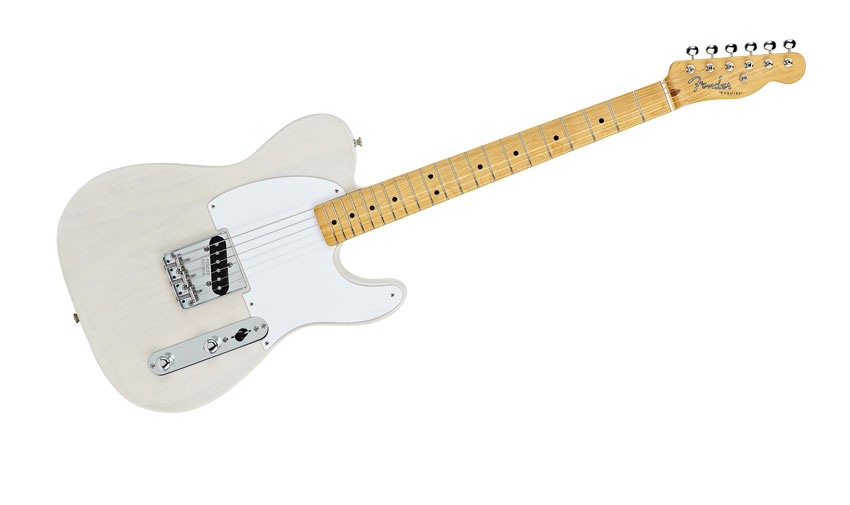MusicRadar Verdict
A well-made, good-sounding taste of Fender's leanest, meanest tone machine.
Pros
- +
Great build quality. Decent tones, especially with outboard help.
Cons
- -
Seems expensive for a minimalist Mexican-made Fender.
MusicRadar's got your back

Fender Classic Series '50s Esquire

Bridge
Fender's single-pickup Esquire pre-dated the Gibson Les Paul Junior, and indeed the Broadcaster/Telecaster, on its introduction in 1950.
Within a year, it had dropped behind the Broadcaster - now called Telecaster - despite being exactly the same guitar without a neck pickup and different wiring (although a cavity for the neck pickup was, from this point, always included). It meant the Esquire cost, in 1951, $40 less than the Telecaster, at $149.50.
Build
"This Classic Series Esquire sticks to mid 50s vintage spec where possible"
The polar opposite to the electrified acoustic archtop jazzbox, Fender's Esquire would have cut quite a dash back in the day. 64 years on, it remains the definition of minimalism. This Classic Series version sticks to mid 50s vintage spec where possible: uncontoured ash body (with additional routing for a neck pickup) under semi-translucent blonde finish, one-piece maple neck/fingerboard with a not too perma-tan tint and, of course, a small-radius fingerboard face and small frets. At this price there's no nitrocellulose: the body is coated in polyester, the neck in polyurethane.
The tray bridge goes with three steel-rod saddles, the late 1954 to mid '58 change that followed the earlier brass saddles. For its solitary single-coil pickup, however, we have the usual two-pickup Tele-style tone, volume and three-way lever switch. The switch, obviously, always voices the single pickup but with a different configuration of the electronics and controls.
So, in position one ('neck' position) we get the volume control with no tone control plus two capacitors and a resistor for a darker tone; position two ('middle' position) voices the normal volume and tone control and position three ('bridge' position) selects the volume control only for maximum treble response.
It's not the lightest Tele we've played, but the neck shape and feel makes up for that - a deep C with that left-hand wraparound comfort of a small radius fingerboard. Set-up and intonation as supplied was fine, and although intonation is more often than not a compromise with just the three bridge saddles, it really wasn't off: if anything, slightly flat, which to our ears is always preferable.
Sounds
With a Gibson '57 LP Junior and Fender '69 Tele as reference instruments, we plugged in the Esquire. Where's our sound gone? Whereas we had a ballsy, crunchy Brit-rock (first time around!) sound from the Junior and only a slightly cleaner tone from the Tele, this sounds like we've taken a gain stage out of our signal chain - it really is a little weedy.
Want all the hottest music and gear news, reviews, deals, features and more, direct to your inbox? Sign up here.
"Increasing the amp's gain, there's a superb sizzle and raunch"
There's a lot of high, piercing 'modern' Tele-ness to the tone in the 'bridge' position; in 'middle' position we can at least use the tone control to tame those highs a bit, and increasing the amp's gain there's a superb sizzle and raunch - we're getting there!
However, in 'neck' position, it sounds like someone has turned a darkly voiced tone control all the way off. To our ears, this needs a more powerful single-coil; as it is, it needs quite a lot of outboard help.
Is the single-pickup guitar valid in 2014? Probably, to a certain player, more so than it's ever been. There's definitely something that engages the primitive essence of rock 'n' roll when you strap one on.
The Esquire is the original electric plank in its most basic form. Some might say it's the coolest looking electric guitar ever, but style aside, while this one might not match the darker power of some 50s Esquires and Telecasters that have passed though our hands, there's little doubt it can still nail anything from original rock 'n' roll through country, soul and onwards to punk.
Dave Burrluck is one of the world’s most experienced guitar journalists, who started writing back in the '80s for International Musician and Recording World, co-founded The Guitar Magazine and has been the Gear Reviews Editor of Guitarist magazine for the past two decades. Along the way, Dave has been the sole author of The PRS Guitar Book and The Player's Guide to Guitar Maintenance as well as contributing to numerous other books on the electric guitar. Dave is an active gigging and recording musician and still finds time to make, repair and mod guitars, not least for Guitarist’s The Mod Squad.
